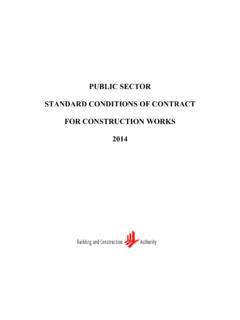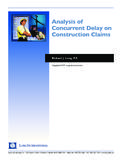Transcription of www.fenwickelliott.com
1 Time, delay and liquidated damages by Nicholas Gould, Partner 1 Introduction Time;. Money; and Possession. 2 Commencement and Completion The obligation to complete. Reasonable time. Is the date for completion binding? Acts of prevention; and Extensions of time. Time is not of the essence. Time being of the essence means that a contractual provision is a condition (not a warranty or an innominate term). Forfeiture would be particularly harsh for a contractor, see United Scientific Holdings v Burnley Council [1978] AC 904 HL and Bunge Cork v Trade SEA [1981] 1 WLR 711 HL. Generally time will be of essence if: The contract states that a condition must be precisely complied with; or There are surrounding circumstances of the contract are such that time must be of the essence. Time can have been made of the essence (Richards (Charles) v Oppenheim [1950] 1.)
2 KB 616 CA). Preserving the right to liquidated damages (Peak Construction (Liverpool) v McKinney Foundations (1971) 1 BLR 111 CA). Advantage of extension of time provisions;. Employer preserves right to liquidated damages;. Contractor is relieved of liquidated damages, but can claim additional costs associated with delays; and Neither party is in breach of contract. 1. Time, delay and liquidated damages 3 The obligation to progress and programme the works The obligation to commence the works and to complete the works on specific dates. This is in reality a benefit to the contractor rather than just an obligation (see Wells v Army & Navy Cooperative Society (1902) 86 LT 764, where Vaughan Williams LJ stated to my mind that limitation of time is clearly intended, not only as an obligation, but as a benefit to the builder . Business efficacy may require an implied term to the effect that the contractor is to proceed with reasonable diligence and also with momentum and reasonable progress during the contract period.
3 How the contractor organises himself is however a matter for him. There is no general implication to execute the works to an absolute standard simply to expedite and with a reasonable diligence. Neither is there a requirement to complete by key dates, unless those dates are expressly contractual (GLC v Cleveland Bridge and Engineering (1984) 34 BLR 50). Temporary non-conformity. In other words, slowness that does not result in a delay to complete the work on time is unlikely to be a breach of contract. The employer has a duty not to prevent the contractor completing the work (see London Borough of Merton v Leach (Stanley Hugh) Ltd 1985 32 BLR 51) but this obligation does not go as requiring the employer to support early completion by the contractor (see Glenlion Construction v The Guinness Trust (1987) 39 BLR 89). Glenlion supports the argument that under English law the employer owns the float rather than the contractor.
4 4 Completion Completion perhaps really does mean entire completion. See the slightly different approaches of Salmon LJ and Lord Dilhorne in Westminster County Council v Jarvis & Sons Limited in Court of Appeal [1969] 3 All ER 1025 and then the House of Lords [1970] 1 All ER 942. Most Tribunals take a pragmatic view. Construction contracts refer to substantial completion, practical completion, although rarely are these terms ever defined. Partial possession. Sectional completion. 5 Extension of time provisions Construed strictly contra proferentem. Contractual logic of such a provision was considered in the House of Lords case of Percy Bilton Limited v Greater London Council [1982] WLR 794 HL as follows: The general rule is that the main contractor must complete the work by the date for completion. If not he is liable for liquidated damages;. 2. Time, delay and liquidated damages The exception to the payment of liquidating damages is if the employer prevents the main contractor from completing his work (see Holme v Guppey (1838) 2 N Wells v Army & Navy Cooperative Society Limited (1902) 86 LT 764); and The general rules may be amended by the express terms of the contract.
5 The risks are therefore allocated between the parties by the particular express terms of the contract. If completion takes place after the agreed date for completion then the contractor is liable for liquidated damages unless: Time is at large because of a delay caused by the employer and there remains some period of culpable delay; or The delay is caused by some event for which an extension of time is available (regardless of whether that event could amount to an act of prevention or a breach by the employer). Clear drafting is required. General wording will not be sufficient. For example, other special circumstances is insufficient (Peak Construction (Liverpool) v McKinney Foundations); and The extension of time might need to be awarded before the completion date, unless the contract provides otherwise (Amalgamated Building Contractors v Waltham Holy Cross UDC [1952] 2 All ER 452 CA).
6 6 Notices and Conditions Precedent The requirement for the serving of notices is usually only directory not mandatory (Temloc Limited v Erril Properties Limited (1987) 39 BLR 30 CA). The requirements for a condition precedent under English law were established in Bremer Handelgesellschaft mbH v Vanden Avenue Izegem PVBA [1978] 2 Lloyd's Rep 109, HL: Precise and clear timetables must be identifiable; and The result of missing the timetable is clearly spelt out. Can a condition precedent in a building contract remove a right to an extension of time, additional costs associated with that right, and perhaps even lead to liquidated damages? City Inn v Shepherd Construction Limited [2003] Scot CS 146. In this case non compliance with the condition precedent removed the right of the contractor to an entitlement of an extension of time. As a result liability for liquidated damages arose.
7 On appeal the point was confirmed although the strict requirement had in that case been waived;. Gaymark Investments Pty the Walter Construction Group Limited [1999]. NTSC 143; and 3. Time, delay and liquidated damages Multiplex Constructions (UK) Limited v Honeywell Control Systems Limited [2007] EWHC 447 (TCC). In what circumstances might the strict requirements of a condition precedent in a building contract barring a right to an extension of time be waived? In the final judgment of City Inn v Shepherd Construction Limited ScotCS CSOH 190 (30 Nov 2007) the judge characterised the time bar clause as an immunity clause that could be waived. The employer and architect made it clear that the contractor would not receive an extension of time, but they did not rely on or refer to the time bar clause as the reason. The judge said that to invoke the immunity of the time bar clause it must be referred to as the reason for not granting an extension of time.
8 7 The role of the contract administrator Dependent upon the drafting of the contract, but generally to consider and make decisions upon the extensions of time. The obligation is to consider the extension of time within a reasonable time. What is a reasonable time depends on the circumstances (Neodox Limited v Borough of Swinton and Pendlebury (1985) 5 BLR 38). Failure to do that can amount to a breach in itself, although what damages flow from this breach? If the contractor does not accept that the extension of time is correct then his remedy is against the employer. Most standard forms state that an arbitrator has the ability to open up, review and revise decisions or certificates. North Regional Health Authority v Derek Crouch [1984] QB 644 concluded that the Court did not have the power to open up, review and revise. Section 43a of the Supreme Court Act 1981 inserted by Section 100 of the Courts and Legal Services Act 1990 partially addressed this issue.
9 The point was then reversed by the House of Lords in Beaufort Developments (NI) Limited v Gilbert Ash (NI) Limited [1999] 1 AC 266. An arbitrator (and no doubt the Court) could therefore open up, review and revise downwards an extension of time granted by the Contract Administrator if it were excessive. 8 The test to be applied when considering an extension of time request Reference must be made to the contract, and the precise terms of the contract. Generally, a contractor would need to demonstrate: There was an event recognised under the contract; and That event has delayed or is likely to delay the works beyond the planned completion date. Roger Toulson QC in John Barker Construction Limited v London Portman Hotel Limited (1996) 83 BLR 31 set out the following criteria which should be considered in order to calculate a fair and reasonable extension of time: Apply the rules of the contract.
10 Recognise the effects of constructive change;. 4. Time, delay and liquidated damages Make a logical analysis, in a methodical way, of the effect of relevant events on the contractor's programme; and Calculate objectively, rather than make an impressionist assessment of the time taken up by the relevant events. FIDIC Red Book 1999 edition requires the engineers to make a fair determination . (Clause ). NEC3 tries to remove discretion where possible (see the calculation for an extension of time in respect of weather in Clause (13)). 9 Assessing an extension of time entitlement The preference to grant a provisional extension of time and then revisit after completion. An objective approach is required. Various methods exist including: Bar chart analysis;. Retrospective critical path analysis (CPM). As planned impacted adds employer cause delays to the planned programme, while as built but for analysis subtracts employer caused delay from the as built programme.
















